Ilya Tolstikhin
Fine-Grained Distribution-Dependent Learning Curves
Aug 31, 2022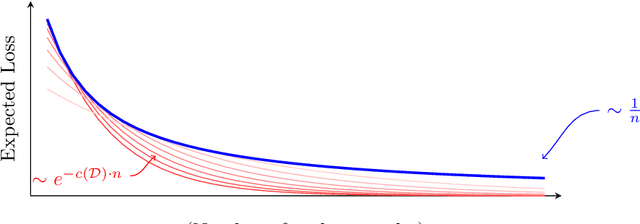
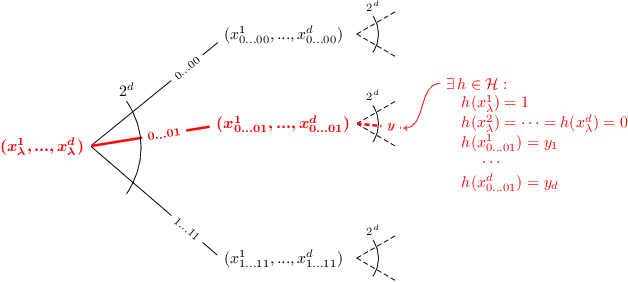
Abstract:Learning curves plot the expected error of a learning algorithm as a function of the number of labeled input samples. They are widely used by machine learning practitioners as a measure of an algorithm's performance, but classic PAC learning theory cannot explain their behavior. In this paper we introduce a new combinatorial characterization called the VCL dimension that improves and refines the recent results of Bousquet et al. (2021). Our characterization sheds new light on the structure of learning curves by providing fine-grained bounds, and showing that for classes with finite VCL, the rate of decay can be decomposed into a linear component that depends only on the hypothesis class and an exponential component that depends also on the target distribution. In particular, the finer nuance of the VCL dimension implies lower bounds that are quantitatively stronger than the bounds of Bousquet et al. (2021) and qualitatively stronger than classic 'no free lunch' lower bounds. The VCL characterization solves an open problem studied by Antos and Lugosi (1998), who asked in what cases such lower bounds exist. As a corollary, we recover their lower bound for half-spaces in $\mathbb{R}^d$, and we do so in a principled way that should be applicable to other cases as well. Finally, to provide another viewpoint on our work and how it compares to traditional PAC learning bounds, we also present an alternative formulation of our results in a language that is closer to the PAC setting.
A Generalized Lottery Ticket Hypothesis
Jul 26, 2021



Abstract:We introduce a generalization to the lottery ticket hypothesis in which the notion of "sparsity" is relaxed by choosing an arbitrary basis in the space of parameters. We present evidence that the original results reported for the canonical basis continue to hold in this broader setting. We describe how structured pruning methods, including pruning units or factorizing fully-connected layers into products of low-rank matrices, can be cast as particular instances of this "generalized" lottery ticket hypothesis. The investigations reported here are preliminary and are provided to encourage further research along this direction.
MLP-Mixer: An all-MLP Architecture for Vision
May 17, 2021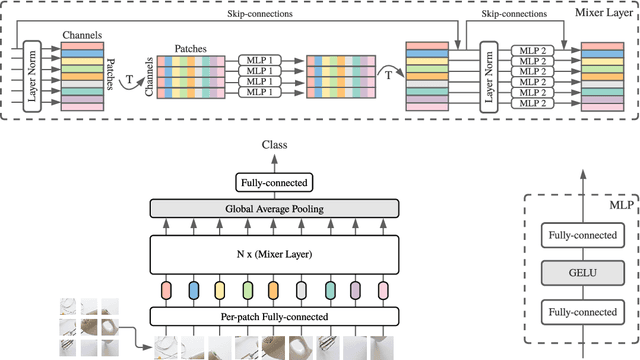

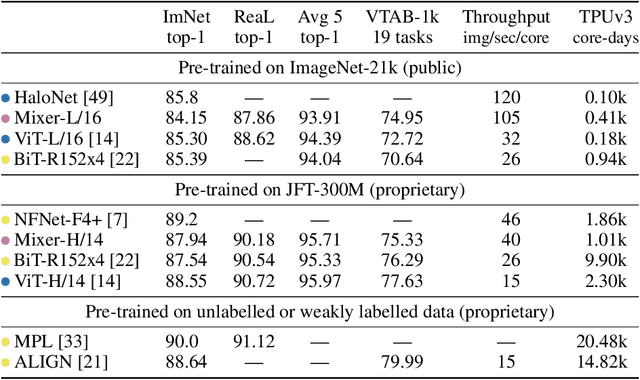
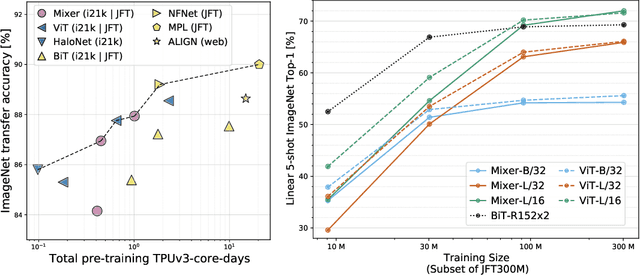
Abstract:Convolutional Neural Networks (CNNs) are the go-to model for computer vision. Recently, attention-based networks, such as the Vision Transformer, have also become popular. In this paper we show that while convolutions and attention are both sufficient for good performance, neither of them are necessary. We present MLP-Mixer, an architecture based exclusively on multi-layer perceptrons (MLPs). MLP-Mixer contains two types of layers: one with MLPs applied independently to image patches (i.e. "mixing" the per-location features), and one with MLPs applied across patches (i.e. "mixing" spatial information). When trained on large datasets, or with modern regularization schemes, MLP-Mixer attains competitive scores on image classification benchmarks, with pre-training and inference cost comparable to state-of-the-art models. We hope that these results spark further research beyond the realms of well established CNNs and Transformers.
What Do Neural Networks Learn When Trained With Random Labels?
Jun 18, 2020



Abstract:We study deep neural networks (DNNs) trained on natural image data with entirely random labels. Despite its popularity in the literature, where it is often used to study memorization, generalization, and other phenomena, little is known about what DNNs learn in this setting. In this paper, we show analytically for convolutional and fully connected networks that an alignment between the principal components of network parameters and data takes place when training with random labels. We study this alignment effect by investigating neural networks pre-trained on randomly labelled image data and subsequently fine-tuned on disjoint datasets with random or real labels. We show how this alignment produces a positive transfer: networks pre-trained with random labels train faster downstream compared to training from scratch even after accounting for simple effects, such as weight scaling. We analyze how competing effects, such as specialization at later layers, may hide the positive transfer. These effects are studied in several network architectures, including VGG16 and ResNet18, on CIFAR10 and ImageNet.
Predicting Neural Network Accuracy from Weights
Feb 26, 2020



Abstract:We study the prediction of the accuracy of a neural network given only its weights with the goal of better understanding network training and performance. To do so, we propose a formal setting which frames this task and connects to previous work in this area. We collect (and release) a large dataset of almost 80k convolutional neural networks trained on four image datasets. We demonstrate that strong predictors of accuracy exist. Moreover, they can achieve good predictions while only using simple statistics of the weights. Surprisingly, these predictors are able to rank networks trained on unobserved datasets or using different architectures.
When can unlabeled data improve the learning rate?
May 28, 2019Abstract:In semi-supervised classification, one is given access both to labeled and unlabeled data. As unlabeled data is typically cheaper to acquire than labeled data, this setup becomes advantageous as soon as one can exploit the unlabeled data in order to produce a better classifier than with labeled data alone. However, the conditions under which such an improvement is possible are not fully understood yet. Our analysis focuses on improvements in the minimax learning rate in terms of the number of labeled examples (with the number of unlabeled examples being allowed to depend on the number of labeled ones). We argue that for such improvements to be realistic and indisputable, certain specific conditions should be satisfied and previous analyses have failed to meet those conditions. We then demonstrate examples where these conditions can be met, in particular showing rate changes from $1/\sqrt{\ell}$ to $e^{-c\ell}$ and from $1/\sqrt{\ell}$ to $1/\ell$. These results improve our understanding of what is and isn't possible in semi-supervised learning.
Practical and Consistent Estimation of f-Divergences
May 27, 2019



Abstract:The estimation of an f-divergence between two probability distributions based on samples is a fundamental problem in statistics and machine learning. Most works study this problem under very weak assumptions, in which case it is provably hard. We consider the case of stronger structural assumptions that are commonly satisfied in modern machine learning, including representation learning and generative modelling with autoencoder architectures. Under these assumptions we propose and study an estimator that can be easily implemented, works well in high dimensions, and enjoys faster rates of convergence. We verify the behavior of our estimator empirically in both synthetic and real-data experiments, and discuss its direct implications for total correlation, entropy, and mutual information estimation.
GeNet: Deep Representations for Metagenomics
Jan 30, 2019

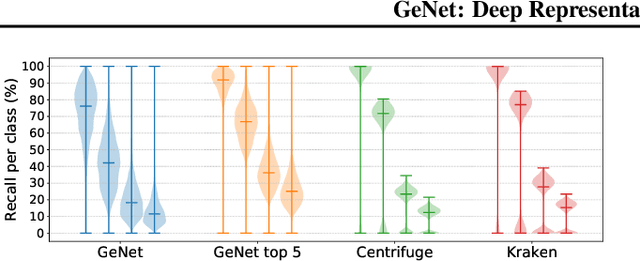

Abstract:We introduce GeNet, a method for shotgun metagenomic classification from raw DNA sequences that exploits the known hierarchical structure between labels for training. We provide a comparison with state-of-the-art methods Kraken and Centrifuge on datasets obtained from several sequencing technologies, in which dataset shift occurs. We show that GeNet obtains competitive precision and good recall, with orders of magnitude less memory requirements. Moreover, we show that a linear model trained on top of representations learned by GeNet achieves recall comparable to state-of-the-art methods on the aforementioned datasets, and achieves over 90% accuracy in a challenging pathogen detection problem. This provides evidence of the usefulness of the representations learned by GeNet for downstream biological tasks.
Clustering Meets Implicit Generative Models
Aug 02, 2018



Abstract:Clustering is a cornerstone of unsupervised learning which can be thought as disentangling the multiple generative mechanisms underlying the data. In this paper we introduce an algorithmic framework to train mixtures of implicit generative models which we instantiate for variational autoencoders. Relying on an additional set of discriminators, we propose a competitive procedure in which the models only need to approximate the portion of the data distribution from which they can produce realistic samples. As a byproduct, each model is simpler to train, and a clustering interpretation arises naturally from the partitioning of the training points among the models. We empirically show that our approach splits the training distribution in a reasonable way and increases the quality of the generated samples.
Differentially Private Database Release via Kernel Mean Embeddings
May 31, 2018

Abstract:We lay theoretical foundations for new database release mechanisms that allow third-parties to construct consistent estimators of population statistics, while ensuring that the privacy of each individual contributing to the database is protected. The proposed framework rests on two main ideas. First, releasing (an estimate of) the kernel mean embedding of the data generating random variable instead of the database itself still allows third-parties to construct consistent estimators of a wide class of population statistics. Second, the algorithm can satisfy the definition of differential privacy by basing the released kernel mean embedding on entirely synthetic data points, while controlling accuracy through the metric available in a Reproducing Kernel Hilbert Space. We describe two instantiations of the proposed framework, suitable under different scenarios, and prove theoretical results guaranteeing differential privacy of the resulting algorithms and the consistency of estimators constructed from their outputs.
 Add to Chrome
Add to Chrome Add to Firefox
Add to Firefox Add to Edge
Add to Edge